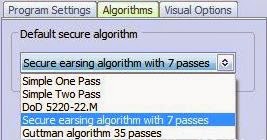Download the "SDelete" utility from Microsoft site - https://technet.microsoft.com/en-us/sysinternals/bb897443.aspx
After downloading extract the contents into a folder such as "C:\SDelete". SDelete implements the Department of Defense clearing and sanitizing standard DOD 5220.22-M.
SDelete is a command line utility that takes a number of options. In any given use, it allows you to delete one or more files and/or directories, or to cleanse the free space on a logical disk. SDelete accepts wild card characters as part of the directory or file specifier.
Usage: sdelete [-p passes] [-s] [-q] <file or directory> ...
sdelete [-p passes] [-z|-c] [drive letter] ...
-a Remove Read-Only attribute.
-c Clean free space.
-p passes Specifies number of overwrite passes (default is 1).
-q Don't print errors (Quiet).
-s or -r Recurse subdirectories.
-z Zero free space (good for virtual disk optimization).
To execute, you can run "SDelete" from the folder where the executable has been downloaded:-
*********************
C:\SDelete>sdelete -p 10 -s -a "c:\test"
SDelete - Secure Delete v1.61
Copyright (C) 1999-2012 Mark Russinovich
Sysinternals - www.sysinternals.com
SDelete is set for 10 passes.
c:\test\test.docx...Scanning file: Reached the end of the file.
c:\test\test.pptx...deleted.
c:\test\test.rar...Scanning file: Reached the end of the file.
c:\test\sample\test-recursive.txt...Scanning file: Reached the end of the file.
Zeroing free space to securely delete compressed files: 10%
**********************
As an alternative, you can use another freeware "FileShredder" - http://www.fileshredder.org/
In this utility, you can select different algorithms for deletion as below:-
After downloading extract the contents into a folder such as "C:\SDelete". SDelete implements the Department of Defense clearing and sanitizing standard DOD 5220.22-M.
SDelete is a command line utility that takes a number of options. In any given use, it allows you to delete one or more files and/or directories, or to cleanse the free space on a logical disk. SDelete accepts wild card characters as part of the directory or file specifier.
Usage: sdelete [-p passes] [-s] [-q] <file or directory> ...
sdelete [-p passes] [-z|-c] [drive letter] ...
-a Remove Read-Only attribute.
-c Clean free space.
-p passes Specifies number of overwrite passes (default is 1).
-q Don't print errors (Quiet).
-s or -r Recurse subdirectories.
-z Zero free space (good for virtual disk optimization).
To execute, you can run "SDelete" from the folder where the executable has been downloaded:-
*********************
C:\SDelete>sdelete -p 10 -s -a "c:\test"
SDelete - Secure Delete v1.61
Copyright (C) 1999-2012 Mark Russinovich
Sysinternals - www.sysinternals.com
SDelete is set for 10 passes.
c:\test\test.docx...Scanning file: Reached the end of the file.
c:\test\test.pptx...deleted.
c:\test\test.rar...Scanning file: Reached the end of the file.
c:\test\sample\test-recursive.txt...Scanning file: Reached the end of the file.
Zeroing free space to securely delete compressed files: 10%
**********************
As an alternative, you can use another freeware "FileShredder" - http://www.fileshredder.org/
In this utility, you can select different algorithms for deletion as below:-

No comments:
Post a Comment